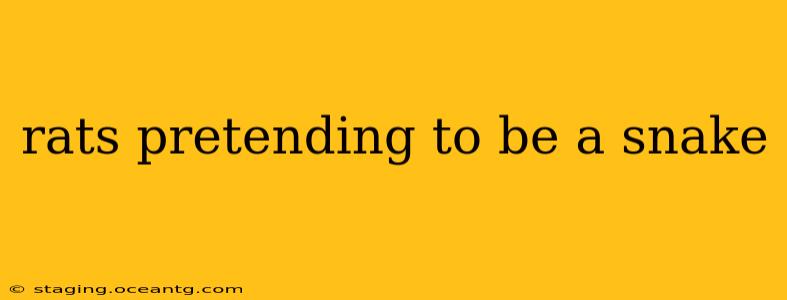Rats, notorious for their adaptability and cunning, sometimes exhibit surprisingly complex behaviors. One such behavior that has intrigued scientists and nature enthusiasts alike is the phenomenon of rats mimicking snakes. While not a true case of mimicry in the evolutionary sense (where a harmless species evolves to resemble a harmful one), the behavior demonstrates remarkable plasticity and intelligence in these often-misunderstood rodents.
This article will delve into the fascinating world of rats mimicking snakes, exploring the reasons behind this behavior, the different ways they might do it, and the implications of this unusual act.
Why Do Rats Pretend to Be Snakes?
Several factors might contribute to a rat's decision to adopt snake-like postures and movements. The most prominent is predator avoidance. By mimicking a snake, a rat attempts to deter potential predators such as cats, birds of prey, or even larger rats. The surprise element and the perceived threat of a venomous snake can effectively scare off attackers, giving the rat precious time to escape.
This is a form of behavioral mimicry, a learned rather than inherited behavior. It's not an innate ability passed down through generations, but rather a learned response to environmental pressures. The rat doesn't genetically "know" how to mimic a snake; it learns this through observation and experience.
How Do Rats Mimic Snakes?
There isn't a single, definitive way rats mimic snakes. The behavior can vary depending on the specific rat, its environment, and the perceived threat. However, some common behaviors include:
- Posture: Rats may stretch their bodies out, flatten their heads, and raise their tails to resemble a snake's posture. This creates a long, slender silhouette that's less rat-like and more reminiscent of a serpent.
- Movement: They may move in a sinuous, snake-like manner, swaying their bodies from side to side rather than running in a straight line. This movement further enhances the illusion.
- Vocalizations: Although less common, some rats may even incorporate hissing or other sounds to complete the impression. This adds an auditory element to their mimicry.
What are the benefits of this behavior?
The primary benefit, as previously mentioned, is increased survival chances. By mimicking a snake, a rat significantly increases its chances of escaping predation. This behavioral adaptation contributes to the overall survival and fitness of the rat population.
Do all rats pretend to be snakes?
No, not all rats exhibit this behavior. It's more likely to be observed in rats that have previously encountered snakes or other predators and learned the effectiveness of this mimicry. The behavior is also likely influenced by individual personality and temperament. Some rats may be bolder and more prone to taking risks, while others are more cautious and less inclined to mimic snakes.
Is it a form of self-defense?
Yes, it can certainly be considered a form of self-defense, though not a direct physical one. It's a behavioral defense mechanism that relies on deception and intimidation rather than physical combat. This strategy is particularly effective against predators that are not naturally inclined to engage with snakes.
Is it instinctive or learned behavior?
The evidence strongly suggests it is learned behavior, not instinctual. Young rats don't inherently know how to mimic snakes. They learn this behavior by observing other rats or through personal experiences with predators. This adaptive learning highlights the incredible cognitive flexibility of rats.
Are there other examples of animal mimicry?
Yes, mimicry is a common phenomenon in the animal kingdom. Many species have evolved to resemble other species for various reasons, including protection from predators, attracting prey, or attracting mates. Examples include the viceroy butterfly mimicking the monarch butterfly, and various harmless insects mimicking stinging insects like wasps and bees.
In conclusion, the behavior of rats pretending to be snakes is a fascinating example of animal behavioral plasticity. While not a true case of evolutionary mimicry, it highlights the incredible adaptability and intelligence of these often-underestimated rodents. Their ability to learn and adapt their behavior to improve their survival chances is a testament to the power of natural selection and the ongoing evolution of species.
